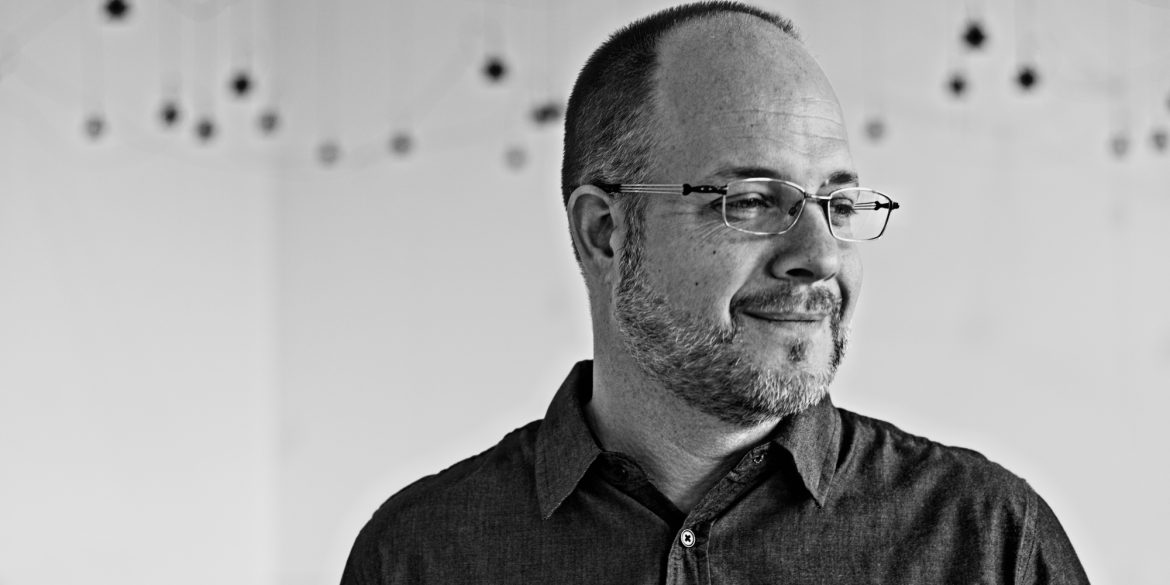Jeremy Shubrook’s office at the Indianapolis Museum of Art is flooded with natural light, the shelves behind his desk are minimally decorated with just a few items. He pulls one down from a shelf and smiles. It’s a black and white photo of contemporary dancer Maureen Fleming shaping her body into a seemingly impossible contortion.
“I will never forget that because of the demands of working on that performance,” Shubrook said of this experience in 1999, early in his career. “There was a set. There were very specific lighting and audio needs and she was going to be performing nude – getting that performance shown at that museum was challenging to say the least. But we did it.”
For the performance, Fleming was wearing a powder-colored, gossamer bodysuit. Due to a car accident that resulted in a piece of her spine being removed, she is able to pull her body into positions unthinkable for most. And this performance, Stairs, required building a large staircase for Fleming to fall down while accompanied by a Philip Glass composition.
“It looks like you are watching a slow motion film. But it’s just her body control,” said Shubrook. “That changed everything for me. Watching that performance, I thought to myself, ‘I’m in. I’m here. This is what I want to do.’ That was what really sealed the deal for me right there. That’s why I keep that picture.”
Shubrook didn’t plan to spend his life working in the arts. After studying political science in college, he worked overseas and then at a greenhouse in Northeast Ohio for three years — barely making ends meet. He spent his free time at the Cleveland Museum of Art.
“The arts have always been in my background but not in my training. Everything I know about performing arts, I learned on the ground, on the job,” he said.
In 1997, he saw there would be a Fabergé in America exhibit at the Cleveland Museum of Art. He decided to apply for a greeter and ticket taker job for the special exhibit. Then, over the course of nine years, he worked his way from security guard to Production Manager for Arts and Film.
“I had an amazing mentor in Massoud Saidpour, the artistic director of the performing arts program at the Cleveland Museum of Art,” said Shubrook. Together they created a world-class performing arts program.
All was well until 2005 when they found out their theater would be closed at least a year for renovation. Concerned they would lose momentum, they decided to take their greatest hits off site to 18 venues. Knowing the move would be difficult for their audience, the two devised a plan to help their audience become comfortable going to new places to see the performance series. They took valet, security, catering with them and made a comprehensive map, complete with the historical relevance of each location.
“Here, there’s a north-south belt divide. There, there was an east-west divide. To get people to go to these places they aren’t use to going, we made it very accessible. Not only were we keeping ourselves alive but re-introducing them to the city they were from,” Shubrook said.
His last three years at the Cleveland Museum of Art overlapped with Charles L. Venable, The Melvin & Bren Simon Director & CEO at the Indianapolis Museum of Art. At the time, Venable was the Deputy Director for Collections and Programs at the CMA.
“In Cleveland, I was impressed by Jeremy’s drive and work ethic,” Venable said. “However, his broad interest in art and performance was what really struck me. When we reconnected in Miami, I felt those qualities had matured and that he would be the perfect person to reimagine how we use our three theaters, galleries, gardens and Park for staging exceptional experience with art and nature.”
During his years in Cleveland, Shubrook had targeted Miami as a place he wanted to land. So in 2007 he went to work at the Adrienne Arsht Center for the Performing Arts. Over a nine year span there, he worked his way from Assistant of Technical Production to Technical Director. One minute he’d be working with itinerant musicians from India and the next minute, maybe with Harry Connick Jr. Shubrook put on 500-plus events a year in Miami.
“I like the variety, “ said Shubrook. “It suits my personality. So here I get that too. We do family programming, we do academic programming, community outreach. I’m going to be bringing more performance back into the mix. It’s my specialty, so my attention will probably be focused more towards that. I’ll support our community programmer, support our teen arts council, our academic programs, our affiliate groups — whatever I can do but still focus in on my artistic niche. Then take that step back and help the department get its work done. “
Shubrook laughs when asked why he chose Indianapolis over Miami. “People aren’t as nice in Miami,” says Shubrook. “What I like about here, which reminds me a little bit of Cleveland, is that DIY ethic. I like that. I see it here.”
Since he’s still new to the position of Director of Festivals, Performance and Public Programs, Shubrook isn’t ready to reveal his plans. But he’s using his perspective and expertise to make choices. “I’ll be asking myself, what can we do that other organizations can’t do on their own or at all, that we can compliment and add to the palette of the city? That’s what I want to accomplish,” he said. “So there might be an instance that feels competitive but that’s not the intention by any stretch of the imagination. There are things I want to do that already exist here. And there are things I want to do here that I think would help inspire people to do more.”
He’s excited about the art audience Indianapolis offers and looks forward to experimenting to discover what types of programming will flourish.
“In Indianapolis we have quite a refined arts audience. I can go to the American Pianists Awards on Sunday afternoon and find it almost completely full at a 300-seat theater at 2:30 in the afternoon. Then the next night, I’m in another venue, the next night I’m in another venue and it’s all doing quite well.”




